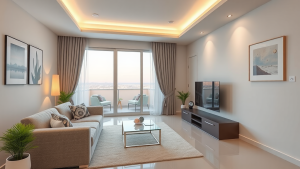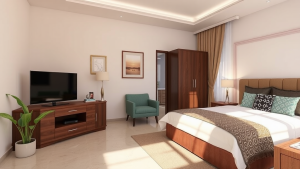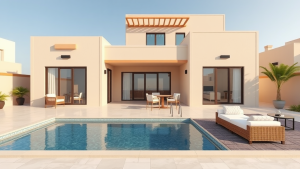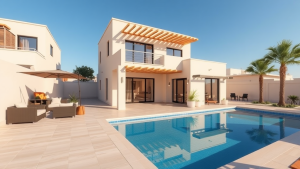Key accessible home features every retiree should consider
As a retiree or someone planning for retirement, ensuring your home is accommodating becomes essential for a comfortable lifestyle. Accessible home features make life easier and safer, allowing you to maintain independence as you age. Here are some key accessible home features you should consider integrating into your living space.
Entryway features
The first step in creating an accessible home starts at the entryway. Here are a few vital aspects to contemplate:
- Zero-Step Entry: A zero-step entry eliminates stairs, making it easier for you to enter your home without assistance. Consider installing ramps or modifying existing steps to create a gradient that is safe and manageable.
- Wide Doorways: Standard doorways may not accommodate wheelchairs or walkers. Widening your doorways to at least 36 inches not only enhances accessibility but increases your home’s functionality.
- Thresholds: Install low or no-threshold doors to ensure a smooth transition from outside to inside. This reduces the risk of tripping.
Bathroom modifications
Bathrooms can present a significant challenge for retirees. Simple modifications can greatly enhance safety and comfort.
- Grab Bars: Install grab bars near the toilet and shower to provide extra support when standing up or moving around.
- Walk-In Showers: Replace traditional bathtubs with walk-in showers to minimize the risk of slips and falls. Slip-resistant tiles and built-in benches improve safety and convenience.
- Raised Toilets: Consider raising the height of toilets to make sitting down and standing up easier.
Kitchen accessibility
Your kitchen should be a place of enjoyment, not a source of frustration. Here are features to consider that enhance accessibility:
- Pull-Out Shelves: Install pull-out shelves or drawers in cabinets to lessen bending and reaching for items. This makes accessing kitchen essentials much simpler.
- Adjustable Counter Heights: Adjustable counters allow you to change heights, accommodating various tasks and situations, which is especially helpful if you’re using a wheelchair.
- Touchless Faucets: Touchless or lever-style faucets minimize the effort needed to operate them and enhance hygiene.
Living room considerations
The living room is a primary gathering space. Here are enhancements that can improve its accessibility:
- Open Layout: An open floor plan allows easier movement with mobility aids. Rearranging the furniture can create clear pathways, reducing hazards.
- Natural Lighting: Ensure adequate lighting to enhance visibility. Installing dimmer switches and using natural light can help create a warm and inviting space.
- Comfortable Seating: Select furniture with the right height and support. Chairs with armrests make it easier to sit down and stand up.
Bedroom enhancements
Your bedroom should be a restful retreat. Adjustments can help you feel more comfortable and secure.
- Bed Height: Choose a bed that is neither too low nor too high, making it simple to get in and out of comfortably.
- Clear Walkways: Clear pathways between the bed and other furniture to prevent tripping hazards.
- Smart Home Technology: Consider using smart devices, such as voice-activated lights and smart thermostats, to make daily tasks easier.
Outdoor spaces
Your outdoor areas can also benefit from accessible features that promote safety and ease of use.
- Even Pathways: Ensure walkways are well-maintained and wide enough for easy navigation, whether you’re walking or using a mobility aid.
- Accessible Gardens: Raised garden beds can make gardening enjoyable without needing to bend down, encouraging physical activity and interaction with nature.
- Outdoor Lighting: Proper lighting improves safety at night and enhances the overall outdoor experience.
By integrating these accessible home features, you empower yourself to live independently and comfortably well into your retirement years. Ensure your home is not just a place to live, but a safe haven that supports your lifestyle preferences and needs. Prioritize these enhancements to create a space that truly feels like home.
Enhancing safety and comfort: adaptations for an aging lifestyle
As we age, our living spaces often require adaptations to ensure safety and comfort. By making specific alterations to your home, you can enhance not only your quality of life but also your independence. It’s essential to recognize that the changes you make can significantly impact your daily routines, allowing you to continue enjoying the comforts of home without unnecessary risks.
Key safety features
Implementing safety features in your home will protect you from accidents and injuries. Here are some modifications to consider:
- Non-Slip Floors: Choose flooring materials that minimize the risk of slipping. Options like textured vinyl, rubber, or carpet can provide better traction, especially in areas prone to moisture, like bathrooms and kitchens.
- Handrails and Grab Bars: Install sturdy handrails on stairs and grab bars in bathrooms. These features provide extra support for moving around the home and can prevent falls.
- Well-Lit Spaces: Ensure that all areas of your home are well-lit. Use bright LED lights and consider motion-sensor lights for hallways and staircases to avoid tripping in the dark.
- Emergency Alert Systems: A personal emergency response system can provide peace of mind. These devices allow you to call for help if you fall or experience a medical issue.
Enhancing comfort
While safety is a priority, enhancing comfort can vastly improve your overall wellbeing. Here are some tips on how to adapt your home for a more comfortable living experience:
- Adjustable Furniture: Consider investing in adjustable beds and chairs that allow you to customize your sitting and sleeping positions for optimal comfort.
- Accessible Storage: Install pull-out shelves and drawers in kitchens and bathrooms to make it easier to access items without bending or reaching too far.
- Temperature Control: Use programmable thermostats and ceiling fans to maintain a comfortable climate in your home. They can help you manage heating and cooling efficiently.
Creating an accessible layout
Your home’s layout should be easy to navigate. Here’s how to make your space more accessible:
- Wider Doorways: If possible, widen doorways to accommodate mobility aids such as walkers or wheelchairs, making it easier to move from room to room.
- Single-Level Living: If stairs are an issue, consider moving to a single-level home or modify your current home to ensure that daily necessities are all on one floor.
- Open Floor Plans: An open layout can reduce clutter and improve navigation. Limit furniture that obstructs pathways, allowing for a smooth flow throughout your living space.
Technology for independence
Technology into your home can substantially improve your quality of life. Here are some helpful tech tools for enhancing safety and comfort:
- Smart Home Devices: Smart lights, thermostats, and security systems can be controlled through your smartphone or by voice commands, enhancing convenience and security.
- Medical Alert Devices: Wearable devices that monitor health statistics and alert emergency services in case of a fall can provide peace of mind for both you and your loved ones.
- Telehealth Services: Utilizing telehealth options allows you to consult with your healthcare providers from the comfort of your home, making medical care more accessible.
By making the right adaptations to your living space, you can enhance safety and comfort as you age. These changes empower you to maintain independence while enjoying a life filled with security and ease. Whether you choose to implement small modifications or undertake larger renovations, every adjustment plays a crucial role in ensuring that your home remains a safe haven.
Consider assessing your living environment regularly to identify additional areas for improvement. Consulting with professionals who specialize in senior living adaptations can further provide insights into advanced modifications tailored to your unique needs.
As you plan for retirement, prioritizing accessible home features can significantly enhance your quality of life. elements such as wider doorways, non-slip flooring, and grab bars not only increases safety but also promotes independence. These adaptations help to minimize fall risks and provide comfort, allowing you to enjoy your home without worry.
Additionally, consider layout modifications that minimize unnecessary movement and strain. Open floor plans and strategically placed furniture can create an inviting atmosphere while also making navigation easier. Bathrooms are crucial areas for accessibility, so features like walk-in showers, raised toilets, and additional lighting can make a tremendous difference in your daily routine.
Ultimately, making your home accessible is an investment in your future. It allows you to age in place, enjoying your surroundings for as long as possible. Embracing these features fosters a living environment where you can thrive, feel secure, and maintain your independence. Remember, it’s not just about modifying your home; it’s about creating a space that enhances your overall well-being and supports a fulfilling lifestyle.
As you embark on this journey, consider your specific needs and preferences. Consulting with professionals specializing in home accessibility can provide insights tailored to your situation. By taking these steps, you are not just adapting your home; you’re embracing a lifestyle that values safety, comfort, and quality of life in your retirement years.
17% discount – exclusive 5 bedroom penthouses with gardens in sahel hasheesh Hurghada under 200k — perfect for belgian retirees
19% off – stylish studio apartments in el helal Hurghada under 50k — sea breeze retreats for danish retirees












